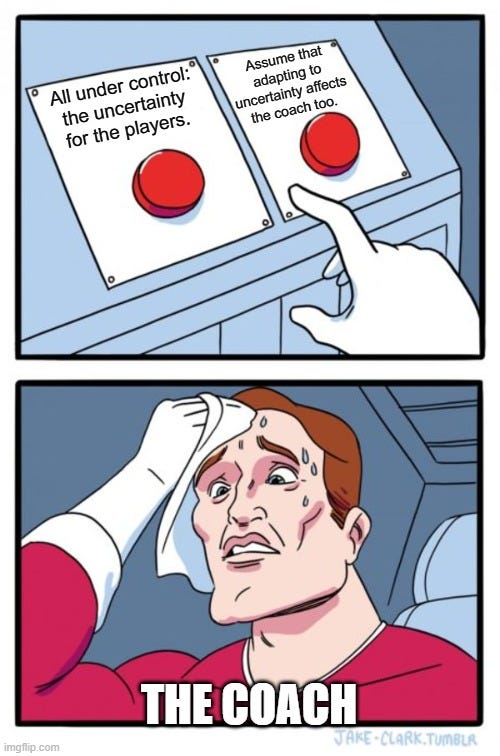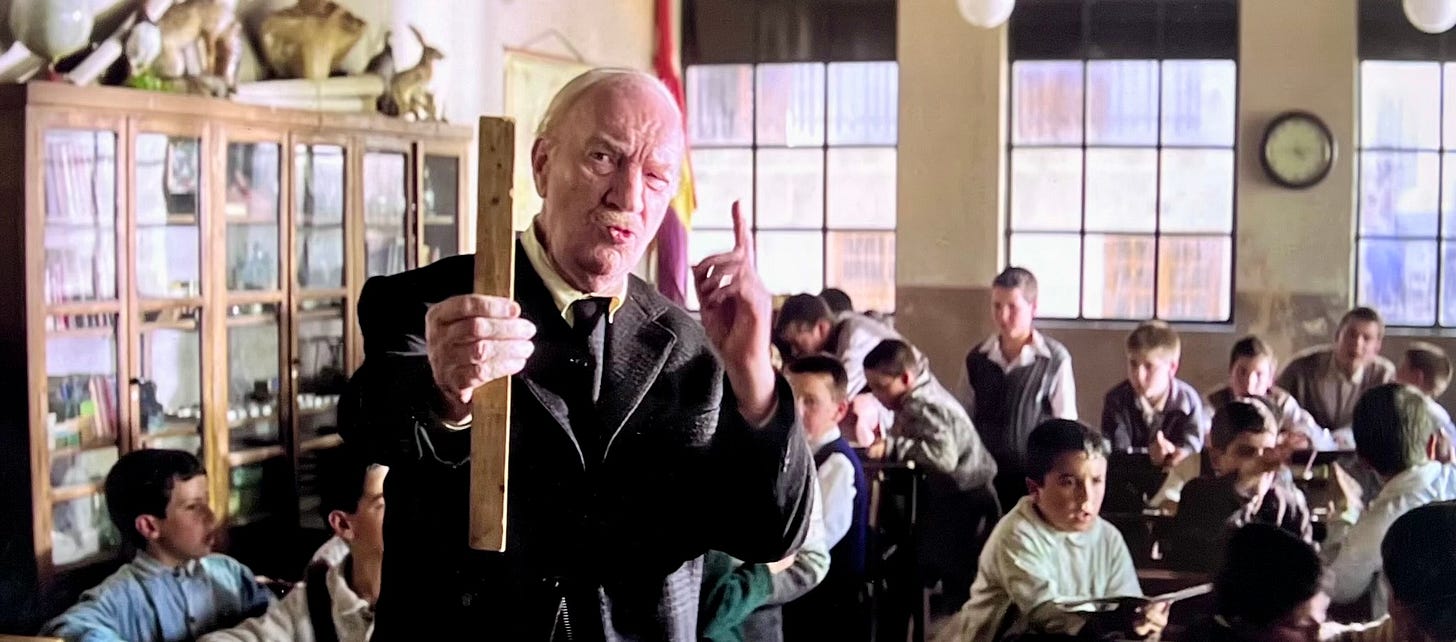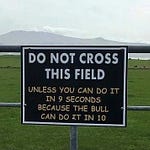Joan Cortés says that coaching is not about knocking over every domino piece, one by one, until the whole chain falls. Coaching is about knowing exactly which piece to push so the entire domino chain falls under its own weight.
The mediocre coach thinks: “Here, I will use that great play from Àlex Terés. There, I am going to apply the technique I learned from Craig Morris…” They focus on their idols and role models —so necessary— and on the past, rather than the moment they are in. They imitate idols who were brilliant at proposing the best solutions for the context they faced. The good coach —Àlex or Craig— focuses on his environment in that present moment. That’s why they are able to find the best proposal for their teams.
Anchored in past lessons, taken out of context, I have learned how difficult it is to adapt to what the present context demands. While preaching that the great player needed to be an expert in adapting to uncertain environments, I pursued expertise as a coach through certainty, forgetting the environment and relying on what I already “knew” and had under control.
“Player, navigate the game! An uncertain journey is unplannable”, I would tell them from the certainty of a rigid game plan. “The drill is uncertain; you must adapt!” I proclaimed, while having every task —and response— of the training session meticulously prepared. “Do not obsess over doing what you know! Do what the situation’s success demands.” Yet, when I had to propose a new task, my thought was, “which of the tasks I already know should we do?” instead of, “what is the best task I can propose? What does the team need?” “It is not about the action you have planned or want to take but the one you find you can take”, I would say, all while being fixated on making the team behave and play exactly as I sought.
I focused the improvement of the player and the team on their ability to respond, to adapt efficiently, to a constantly changing, uncertain environment. But did not I need the same thing to be a good coach? I assumed that the player’s performance took place by engaging with the environment, but that the coach’s performance emerged from memorizing the great training books of history, from knowing —and repeating— what had worked previously and the methods of the great past coaches.
No. The coach’s performance, the knowledge, also emerges close to the context, not by isolating oneself from it. Listening to Messi narrate what he did in his greatest plays and memorizing it does not enable you to replicate it. It does not work that way. For those of us who play from the sideline, from the technical area, it is the same: the secret does not lie in knowing and applying what Guardiola did.
It is not the ability to label or memorize that brings us closer to success. It is the attentive responsiveness to ebbs and flows of an environment that is never quite the same from one moment to the next. Do not worry about capturing the sport, it does not matter if your playbook is not that big… as long as you perceive the environment and adapt to what you encounter.
Bernstein said that dexterity is not an act but the efficient interaction with a dynamic environment. He was speaking from a motor perspective, focusing on the athlete. But is not it the same for the coach? Dexterity is the motor ability to quickly find a correct solution for a problem in an unexpectedly changing environment. Could we remove the “motor” aspect he mentions? That is, dexterity is not limited to an athlete’s movement; it also applies to the coach and the team. A dexterous player, athlete, coach, or team could be defined as those who have adaptation wits in any condition.
The efficient behavior of the player is not based on the “perfection” of movements achieved by repeating models, memorizing commands, or instructions. The team’s performance does not emerge from the decontextualized and repetitive perfection of certain collective patterns. A coach does not intervene efficiently by memorizing all possible game situations and the best tasks ever done by previous coaches. Efficiency in the behavior —of the player, the team, and the coach— emerges when there is attunement to the decisive possibilities of action in the environment they are in. When they perceive their surroundings, the meaningful information, and provide the best response in that situation, what is relevant, what the context requires. And it is quite likely that the need in that particular environment cannot be satisfied by any task of Josep Guardiola i Sala or play from Željko Obradović. Because this is what makes these geniuses great: their success is not in memorizing, copying from different contexts, or retrieving from the past… it is in reasoning in the moment, in creating within a present environment.
The environments the team navigates are not at all different from the contexts the coach encounters. Are the problems a coach faces not uncertain, unpredictable? Can the coach “play” the uncertain game from the certainty of the bench or the whiteboard? Now I understand why Albert Batalla told me that “the teacher’s discomfort is the price to pay for the student’s growth”.
The team and the player move through an uncomfortable terrain, no different from the one the coach walks. The player, team, must find a “motor” response to the challenges and problems so uncertain and changing, that competition presents. The coach faces similar challenges, but his response, his adaptation, is not “motor” —since he cannot score goals or make passes— but of a different kind.
Both the player and the coach must perceive and act. It is crucial that they perceive the relevant information in the context they are in, in order to act efficiently toward their purpose. In the pursuit of victory, the team, the player, and the coach must co-adapt to the opponent, perceiving and acting. The player does this through (inter)actions on the field; the coach does so from the sideline.
Each component perceives and acts influenced by the “whole” they are part of, shaped by the walls and slopes of the home that is the team. This perception-action cycle unfolds within a team governed by its own unwritten norms and system of governance. The cycle is rooted in the shared, unspoken values of the entity that is the team. The perception each component transforms into action is guided by a purpose the group seeks to achieve collectively. The internal dynamics of the team shape which opportunities for action are perceived as viable to accomplish that shared purpose. A shared purpose that tells every component interacting, perceiving, what the team has agreed is good and what is not, what one can do and what one cannot.
Because it is not just those playing on the field who perceive and act. From the sideline or the training ground, the coach lives through the same perception-action cycle. However, his actions are not based on motor skills, on physical movements. His perceptions transform into tasks, interventions, silences, norms, proposals, “tactics”, challenges, questions, reprimands… all aimed at making the collective as efficient as possible.
The foundation of the behavior, however, lies in the perception of the environment in which the team is immersed. It does not stem from the “knowledge” of decontextualized past experiences. That is, a mediocre interior designer might base their work on visiting store after store to find the best fit for their client’s demands. A good interior designer, however, is someone who has the skill to create —or commission the right carpenter to create— the perfect piece of furniture for the specific needs of the context. Perceive and act; not memorize and force a fit. It is far more relevant to know how to propose the right play, the right drill, for the context you are in, than to have a great memory of things that worked in the past.
La Lengua de las Mariposas is a masterpiece of a FILM featuring a TEACHER as they ought to be: Don Gregorio does not just lecture academic “knowledge” that is forgotten the moment students leave the classroom —he does the exact opposite. However, there is one scene I find fascinating. The only moment that I would like to question to Don Gregorio.
While he enthusiastically explains at the blackboard —with his back to the class— the diagrams he has created to explain how to measure a pumpkin... the students, behind him, are doing everything but paying attention. I imagine it was the best method he could find, based on all his extensive experience. It must have been an extremely good and useful technique in all the contexts he had been immersed in... but it lost all relevance in that present context. Because it is not about techniques, not about high-quality methods. The impact we make on individuals, teams, who move through different contexts requires efficient and unique adaptation. And perhaps, at that moment... the intervention that Don Gregorio’s environment called for was something else entirely.
That great game play you cherished and implemented 15 years ago is neither inherently good nor bad. It was useful in a specific context. And that’s it. Before applying it again, you need to put it to the test. Have you immersed yourself in the present context and selected the relevant information to achieve the team’s objective? Is that cherished play the best response to the environment you are in? Because the key is that everything you do brings the team closer, not further away, from attunement with the environment, from the key sources of information of the context. You need to ensure they play beautiful basketball, not just a “memory” game of past plays. Because this —whether you are a player or a coach— is about knowing where to attend, where to look. Not about studying, cramming, memorizing, or repeating.
The movie, however, is excellent. And for me, as someone who impacts so many lives, I would love to have even a hint of the dexterity that Don Gregorio shows throughout the film.
That’s why we must be careful with the information we convey to players or coaches in learning processes. What you present as relevant, does it facilitate or hinder their perception of the meaningful information in the environment?
Coach, be cautious with over-cognitivizing the game and your desire that every player on the team can explain verbally the “tactical” reasons behind your play. Knowledge about tactics independent from lived experience has no value. Similarly, as an instructor of (un)coaching courses, beware of the decontextualized information you provide, assuming it will aid aspiring coaches in navigating the uncertainty of daily training challenges. Do not overwhelm players, teams, or coaches with knowledge about the game. Do not steal from them the opportunities to grow their own knowledge of it.
Because —playing, coaching— is not about memorizing knowledge about a past environment, but about living a new environment. Memory and instruction do not guarantee the discovery and attunement to the key sources of information in the environment that bring you closer to what you want… which, whether you are a player or a coach, is what will lead to performance. In fact, many coaching books and courses from federations that —”supposedly”— look out for sports and its development, take you further from this. They do not prepare us to perceive and act, but to cram and regurgitate. It is not about controlling, classifying, labeling, or storing. It is about the meaningful response-ability in crossroads we have never encountered before.
It is the dexterity. The skill —of the player, the coach, the physiotherapist, the team— to provide an adequate solution for the team in an unexpectedly changing and challenging environment. It is about becoming more efficient and less constrained by the environment… whether you are in the starting eleven or in the technical area. It is not a trait you are born with, nor is it a luxury for a selected few… it is the ability to interact efficiently with a dynamic context.
The dexterous coach makes every intervention —active like an instruction, or passive such as saying nothing— adequate for the posed problem in the context. The dexterous coach is not the one with the fullest folder, nor the one who knows all the “techniques” or “tactics”… but the one who masters the attunement to the environment, the eficient adaptation according a governing purpose.
The intervention of the dexterous coach —session design, proposed game model…— does not emerge from past memory but from their current perception. And once they have intervened —preparing and proposing the training—, they remain alert: perceiving and acting. Like the governor of a citadel, overseeing their domain from above, perceiving and acting does not mean over-intervening —causing harm through iatrogenics. It means staying awake, constantly assessing, and intervening actively only when necessary. Only if what you plan to do is better than doing nothing. Because doing nothing is also a form of intervention. And doing nothing is far, far better, than causing harm. It is a bit like when to speak or shut up: if what you are going to say is not more beautiful than silence... do not say it, keep it for yourself.
It is not about reading Herr Pep or The Art of War and following them to the letter. It is about having an efficient relationship with the problems, needs, and specificities of the environment that, at every moment, the coach is part of. And if in this contextual search for efficiency there is any ideal lesson from Josep Guardiola i Sala or Sun Tzu… take it. But do not examine the finger when the wise man points at the moon. The secret is not in what they did, but in what they perceived to act in that way.
Do not let what happened to some (un)coaches of Catalan athletics happen to you: when the back squat was all the rage, one of the best discus throwers in the world came to train in Barcelona. Many Catalan (un)coaches went to see him and were surprised to find that in the gym, he was doing front squats, not back squats like every other athlete. All the athletes from the (un)coaches of that group who had attended the discus thrower’s training sessions started incorporating front squats into their own trainings. After all, if the best in the world was doing it... Some time later, this thrower returned to Barcelona, and to the surprise of many, he was no longer doing front squats —he was back to back squats. One of the Catalan (un)coaches —finally!— approached his coach and asked why they changed the bar position, why not front squats anymore. The humiliating response was: “Oh! His shoulder injury has healed…”
Because coaching is not about copying, keeping, adding and repeating a vast collection of recipes, drills, plays, “techniques”, that have worked in the past and methods from the world’s best coaches fresh in your memory, ready to be applied.
Coaching is not that at all.
For a true coach, coaching is about adaptation —it is ultimately about knowing exactly which domino piece to push so the entire chain falls under its own weight.
Martí Cañellas | Fosbury Flop













